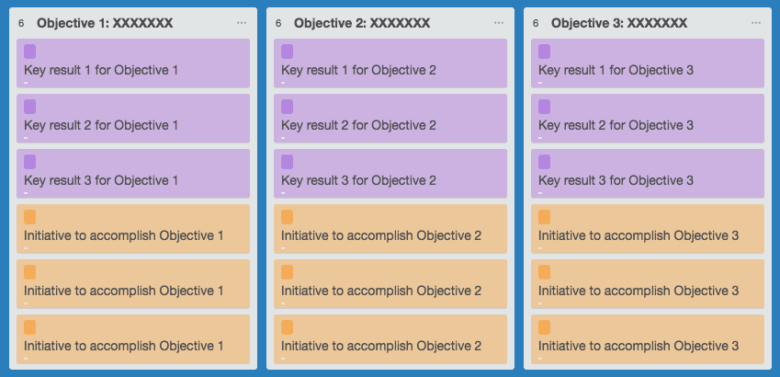Typically you see posts about setting business goals towards the end of the year or the start of a new year, so apologies if this post seems out of place. The truth is, if you don’t have specific goals set for your business, NOW is the best time to set them.
Unfortunately most of the prospects we chat with (eCommerce companies) simply don’t have specific, reasonable eCommerce Marketing goals established. My hope is that this post will be an inspiration to set some basic goals for your eCommerce business and give you the tools you need to do just that.
Establish a Goal Setting Framework

We’ve modified the OKR framework a little to make it work better for us. For example, we also associate “initiatives” or projects that will help meet the key results for each objective. In addition, key results don’t always have to be Key Performance Indicator (KPI) metrics, they can also be projects that are either complete or incomplete.

Choosing Your Objectives
Objectives should be ambitious, qualitative, time-bound, and actionable by the team, according to WeekDone.com. Additionally, Objectives for eCommerce marketing typically fall into one of these three buckets: Increase Revenue, Decrease Costs or Increase Customer Loyalty.
Example eCommerce Marketing Objective
Objective 1: Increase Revenue From Returning Customers
I like all Objectives to utilize the same time period for clarity. I typically recommend setting the “time-bound” component of the Objective at 1 year.
In addition, you’ll want an owner for each objective. There may be multiple teams executing initiatives that help meet key results, so ideally this owner will have some authority over the people involved cross-departmentally if necessary.
Choosing Your Key Results
Key Results, aka Key Performance Indicators (KPIs), comprise the goal part of OKRs.
Traditionally, key results were supposed to be set very aggressively with the understanding that reaching 70% of a key result was the “norm”, anything below that is underperforming. Why be harder on yourself than necessary? Set the key results to a “reasonable” goal level that you fully expect to achieve. Ask yourself these questions to help keep you in check:
• Have we ever achieved a similar result before? If not, what will enable us to do so now?
• What will happen if we don’t hit this key result?
• What is driving this key result (company overall revenue goal, shareholder pressure, something else)? Hint: If it is perceived performance of a competitor you should have data to prove your assumptions are correct, otherwise maybe rethink this key result.
According to WeekDone.com, Key Results should be measurable and quantifiable. And Buffer writes that key results can be quantifiable in a few ways, including binary (yes or no), incremental, volume results or volume events.
Example Key Results
Key Result 1: Achieve $50,000 revenue as a result of new marketing automation sequences (incremental)
Key Result 2: Implement a VIP Customer program (binary)
Key Result 3: Improve Conversion Rate for Returning Customers by 20% (incremental)
There are several great blog posts on choosing eCommerce KPIs, which might give you some good ideas not only for various metrics to choose as key results, but also what objectives might meet your needs. Here are a few of the better ones I’ve found:
• 32 KPIs for eCommerce
• Important eCommerce Metrics
• 12 eCommerce KPIs You Must Monitor
• Key Performance Indicators for eCommerce
• The Most Important eCommerce KPIs
Aligning Initiatives with Objectives and Key Results
Now that you’ve got your Objectives and key results planned out, it is time to define what exactly you are going to do in order to meet each key result. We call these projects “Initiatives”.
You’ll want a high-level list of initiatives/projects alongside your OKRs but you should continue to manage your initiatives and team using the project management tools currently in place at your organization.
Example Key Initiatives
Initiative 1: Set up and launch Abandoned Cart, Win Back, and Upsell marketing automation sequences
Initiative 2: Set up and run a poll on the site for returning customers only. Use feedback to determine tests to run on the site
Initiative 3: Run at least 3 tests on the site targeted towards returning customers
Initiative 4: Implementa VIP Customer program including marketing automation
Monitoring and Reporting on eCommerce OKRs

Here is an example Trello board you can copy to help get you started. In addition, this article gives some helpful hints about how “pretty-up” the Trello board with charts, images, etc as well as some more helpful background information on OKRs. And here’s how our Conversion Optimization team uses Trello for project management.
You can also use our eCommerce KPI dashboard, which utilizes Google Sheets and SuperMetrics, to automatically pull some core KPIs that may make up some of your key results. In addition, you can enhance that dashboard using the same tools to pull information from other sources to help keep tabs on all of your key results.
Avoid These OKR Gotchas
The following is a list of “Don’ts” you should avoid in the process of setting OKRs along with initiatives:
• Don’t select more than 5 Objectives for a year long cycle. Consider less than five objectives for shorter cycles.
• Don’t forget to include people from all levels of the company to help with this process. Doing so will promote “buy-in” and alignment that you’ll need to be successful.
• Don’t set unrealistic key results. Make sure to validate your key results vs reality!
• Don’t set key results that are unrealistic due to current resources, budget, or otherwise.
Wrapping It Up
Setting eCommerce Marketing goals is a must-do exercise for a company interested in long term success and growth. Doing so will align your teams, create buy-in across the company, keep everyone focused on what is important, and ultimately lead to success. Using a framework like OKRs can help you focus on the goals, KPIs and initiatives required.
Happy Growing!
Source: Inflow
